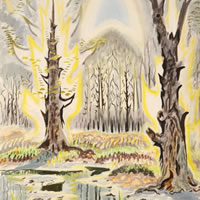 Beyond the Notes:
Beyond the Notes:
Watercolors
The Music
In Watercolors, Nell Shaw Cohen creates a sonic atmosphere that expresses her interpretation of each of the paintings; both on a general level of mood or ambiance, and through specific musical details that relate to visual elements in the paintings. Here is a guide to some of the more prominent musical ideas that relate to identifiable features of the paintings.
See below for images and details from each of the paintings, text from the composer describing her interpretation, and audio clips of relevant excerpts from the music.
I. An April Mood
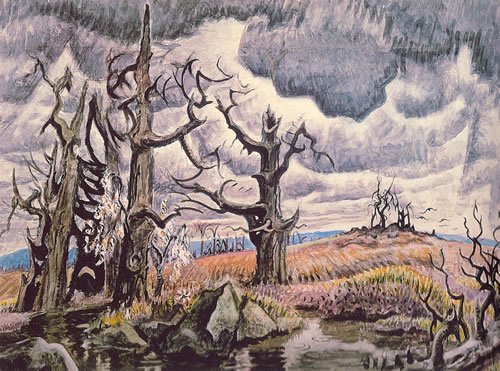
"I feel this painting has a lonely, introspective quality, yet it captures the unique and noble beauty of a stormy spring day. I chose to begin this movement with a horn call, echoed by the bassoon, that captures this juxtaposition of loneliness with nobility (the latter a quality traditionally associated with the horn)."
"Repeated notes in the upper winds were my attempt to evoke the pitter-patter of raindrops, and the overall sense of movement in the windy atmosphere of the painting."
"Burchfield creates a dark, almost angsty, image (exemplified by the dead, barren trees in the foreground) with an underlying sense of hope for the coming spring. There is a section in the music that is repeated and varied in the piece (and ultimately ends it), which represents Burchfield's poignant sense of yearning for spring and wonderment at the regenerative powers of nature."
Download the complete recording of "An April Mood".
II. Autumnal Fantasy
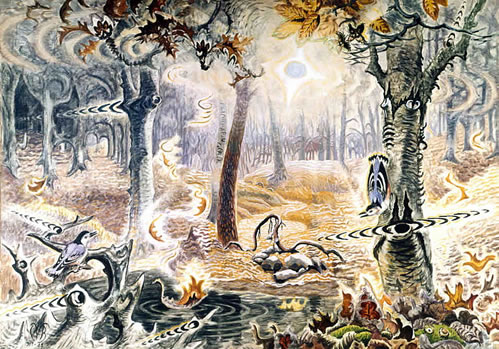
"This painting is remarkable for its depiction of sound. Burchfield symbolizes bird calls and insect noises with abstract 'reverberating' shapes. The viewer is given a rich sense of the world of noises in these woods, and so it was an irresistable choice for me to base this piece on musical motives that resemble bird calls or insects. They are meant to suggest such sounds, rather than recreating any individual animal noise."

"This staccato bird/insect music is juxtaposed throughout the movement with slow, lyrical, chordal music. In its first appearance, this music represents the incredible sun in this painting (or "diamond star", as Burchfield called it), which for me evokes a warm, healing light."

"Slow, chordal music returns later in the movement with a more haunting mood. This music represents the darkness in the lefthand background of the painting--the woods appear to extend far into the distance, which suggests that the forest contains a mysterious realm beyond our view."
Download the complete recording of "Autumnal Fantasy".
III. Sun and Rocks
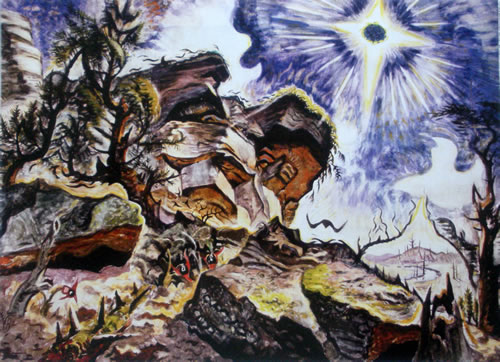
"This painting is incredibly bold: high contrasts between light and dark, strong colors, and dramatic, sharp contours, and I wanted to create a sonic palette that reflected this. I scored the ensemble in the extremes of the high and low range for the primary section in the piece (which undergoes a series of variations). I also chose to include piccolo flute in the place of C flute for just this movement. Its register is extremely high in comparison with the other instruments, and it expands the range of the ensemble and the contrast between registers."
"There are extended sections in the music where layers of throbbing, swelling, dissonant notes stretch out over each other. I was attempting to capture both the physical sense of vibration, and the otherworldy, hallucinatory quality, in this painting--Burchfield's image and my music reverberate with waves of heat, sound, energy, or all of the above."
Download the complete recording of "Sun and Rocks".
IV. Glory of Spring
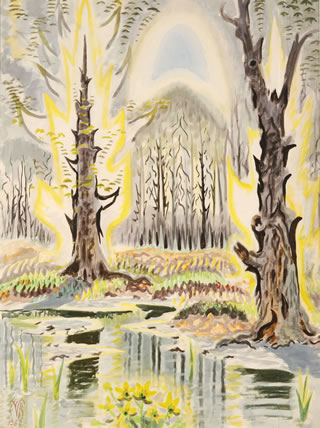
"'Glory of Spring' to me is almost simple--both visually and emotionally--in comparison with the other more tumultuous, complex paintings in this set. Accordingly, this movement is shorter and more lyrical than the others.
The movement centers on a melodic theme, stated most prominently by unaccompanied horn, that has a nostalgic quality. For me, this melody, and the clear, pure sound of the horn in its upper register, reflects the peaceful beauty in this painting. It isn't joyous or overbearing--it is gentle, light, and has a healing quality."
"The feeling of clarity and light, simple beauty, is also expressed through lush, high-register chords which echo the golden light in the painting ("liquid light", as Nancy Weekly sees it)."
"There is a lovely balance of visual elements in this painting, and an unmistakable suggestion of holiness--the sky and trees even resemble the architecture of a cathedral. The aesthetic of Renaissance music sees beauty in balance and subtle nuance, and through church music, it's also inextricably related to our sense of the holy. At the time I composed Watercolors, I was studying Renaissance vocal polyphony, so I incorporated some imitative counterpoint techniques adapted from polyphony into this movement."